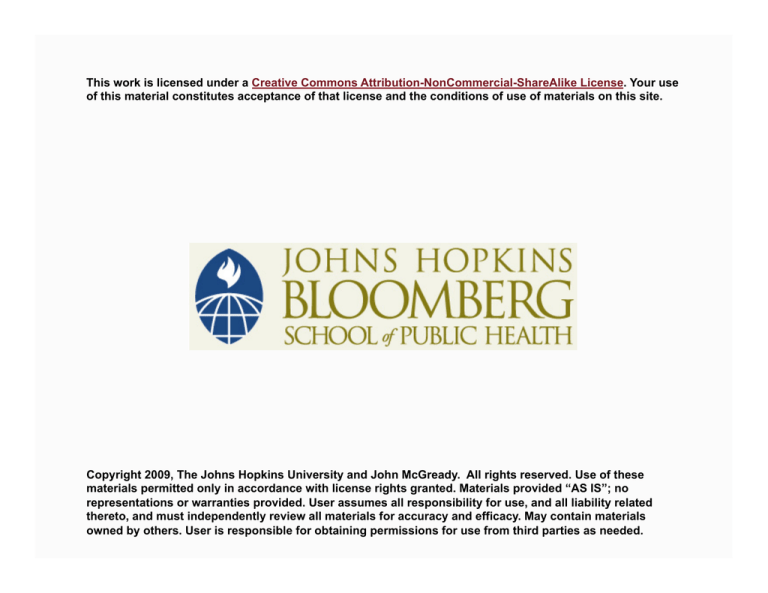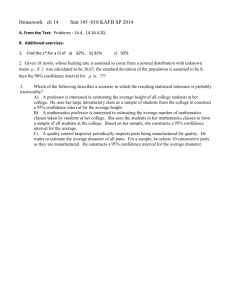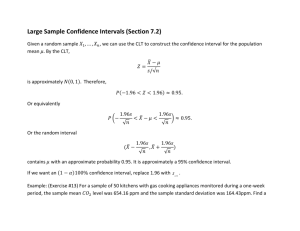
This work is licensed under a Creative Commons Attribution-NonCommercial-ShareAlike License. Your use
of this material constitutes acceptance of that license and the conditions of use of materials on this site.
Copyright 2009, The Johns Hopkins University and John McGready. All rights reserved. Use of these
materials permitted only in accordance with license rights granted. Materials provided “AS IS”; no
representations or warranties provided. User assumes all responsibility for use, and all liability related
thereto, and must independently review all materials for accuracy and efficacy. May contain materials
owned by others. User is responsible for obtaining permissions for use from third parties as needed.
Lecture 3c: Practice Problem Solutions
John McGready
Johns Hopkins University
Estimating a 95% Confidence Interval
Suppose an independent environmental group computes the gas
mileage for a random sample of 100 new models of the same car
make and model in order to make a statement about the gas
mileage of this make and model. The results on these 100 cars
include the following summary statistics:
- Sample mean mileage, 31.4 mpg
- Sample standard deviation: 1.2 mpg
- Sample median: 31.2 mpg
3
Estimating a 95% Confidence Interval
Assuming the gas mileage data is normally distributed, estimate a
range of gas mileage for most (95%) of the cars of this make and
model based on the sample results
- If the sample data comes from a distribution of normally
distributed values, then we can estimate this interval from the
sample results by using
-
In this example, applying this logic gives an interval of
4
Estimating a 95% Confidence Interval
2. Without assuming normality, estimate a range of gas mileage for
most (95%) of the cars of this make and model based on the sample
results.
- This is a trick question: given only the sample mean, median,
and standard deviation, it is not possible to answer this
question. One may note that the mean and median are similar
in value and hence the sample distribution is likely symmetric,
but this cannot be verified with a histogram or some other
approach. If we had the appropriate sample percentile values
(2.5th and 97.5th), then this question could be answered
without assuming normality.
5
Estimating a 95% Confidence Interval
3. Assuming the gas mileage data is normally distributed, estimate a
95% confidence interval for the mean gas mileage for all cars that
are this make and model.
-
As the sample is large, we can go ahead and estimate a 95% CI
for the true average gas mileage among all cars of this make
and model using the CLT based formula,
,
-
i.e.,
-
For these sample results, this gives:
-
6
Estimating a 95% Confidence Interval
4. Without assuming normality, estimate a 95% confidence interval for
the mean gas mileage for all cars that are this make and model
- Actually, the normality assumption about the original individual
data is NOT needed to use the CLT based approach to create a
95% CI for the true underlying population mean of the
population from which the sample was taken
- Hence the answer to this question is EXACTLY the same as the
answer to the previous question (3)
- This highlights one of the powers of the CLT result: that we can
estimate a valid confidence interval for a population mean
using only a single random sample of data, regardless of what
the population distribution (and random sample distribution) of
the individual level data is
7
Estimating a 95% Confidence Interval
5. What is the difference in the interpretation of the intervals
created in questions 1/2 and questions 3/4?
- This is a very important distinction
- The first two questions deal with estimating an interval that
contains most (95%) of the individual (car) level values (gas
mileage) in the population of all cars of this make and model: it
is giving a range for individual observations
- This interval is NOT a confidence interval, and requires specific
characteristics of the population/sample data if it is to be
estimated using only the sample mean and standard deviation
8
Estimating a 95% Confidence Interval
5. What is the difference in the interpretation of the intervals
created in questions 1/2 and questions 3/4?
- The second set of questions asks for a 95% confidence interval
for a single summary measure about the population from which
the sample was taken
- A 95% CI gives a range of plausible values for a single population
summary quantity (like a mean) using the information in a
single sample to estimate the sampling error in the estimated
sample mean
- This 95% CI is NOT a range of possibilities for individual level
values in the population from which the sample was taken, but
a range of possibilities for a single number describing this entire
population—in this case a mean
- This can be estimated without making assumptions about the
distribution of individual level values in the sample/population
9








